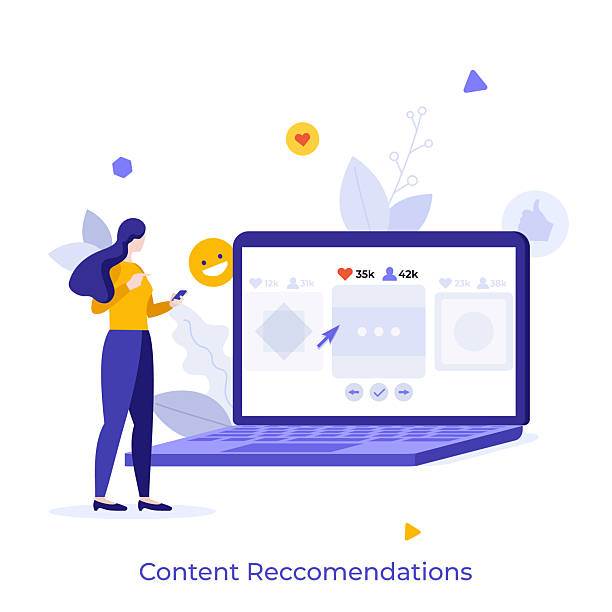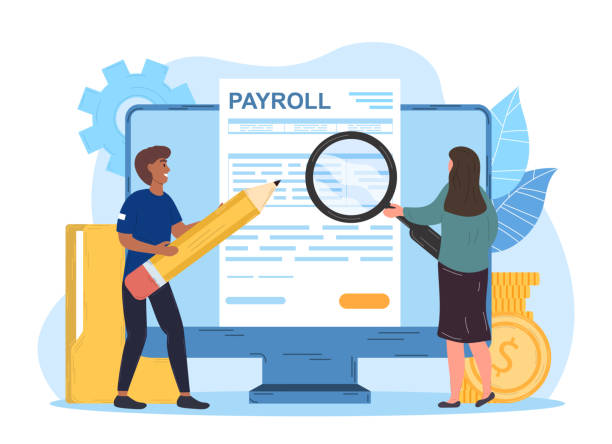The Importance of Responsive Website Design in Today’s Age

In today’s digital world, where users access the internet from a variety of devices such as mobile phones, tablets, laptops, and even smart TVs, #ResponsiveWebsiteDesign is no longer a luxury option, but a vital necessity.
This approach in #WebDesign allows websites to automatically adjust their layout and content to the screen size of the user’s device.
Imagine having a website that looks small and unreadable on your mobile phone, constantly requiring zooming; this user experience is not only annoying but quickly leads to losing visitors.
Recent statistics show that a significant portion of internet traffic comes from mobile devices. Therefore, if your website is not optimized for these users, you will effectively lose a large part of your potential audience.
The main goal of responsive website design is to provide a seamless and optimized experience for all users, regardless of the device they use.
Do you know how your website can display flawlessly on any screen, from the smallest smartphone to the largest desktop monitor, without effort? This article delves deep into this very topic.
Are your online sales not as expected? With Rasawep, solve the problem of low sales and poor user experience forever!
✅ Increase visitor-to-customer conversion rate
✅ Create an enjoyable user experience and increase customer trust
⚡ Act now to get free consultation!
Why has Responsive Design become a New Standard for the Web?

In the not-too-distant past, websites were primarily designed for desktop displays, and mobile users had to contend with scaled-down versions or separate applications.
But with the advent of smartphones and tablets, the number of internet-connected devices suddenly surged, and the variety of screen dimensions became a major challenge for web designers.
This is where the concept of Responsive Design came into existence.
This approach was a logical response to market needs; a need that was strongly supported by tech giants like Google.
Google has explicitly stated that it prefers responsive websites in its mobile search rankings, which alone is a decisive reason to adopt this standard.
This paradigm shift not only provided a better experience for users but also brought numerous benefits to businesses, including reduced maintenance costs (as only one version of the site is managed) and improved SEO.
This was an important news development in the web design industry that forced many webmasters and companies to re-evaluate their strategies.
Did you know that Google even provides special tools to test website responsiveness?
Key Principles and Components of Responsive Design

To deeply understand responsive design, you must be familiar with its three fundamental principles: Fluid Grids, Flexible Images, and Media Queries.
Fluid Grids use relative units (like percentages) instead of fixed pixels to define column widths and elements, allowing the layout to dynamically adjust to the screen size.
Flexible Images, similarly, automatically adjust their size based on the available space, preventing them from overflowing or creating horizontal scrollbars.
However, the backbone of responsive design is Media Queries.
These CSS commands allow designers to apply different style rules based on device characteristics (such as screen width, orientation, or resolution).
For example, you can define that on screens narrower than 768 pixels, the navigation menu appears as a hamburger button instead of horizontally.
This powerful combination of techniques enables the creation of unparalleled user experiences.
This specialized approach not only maintains visual aesthetics but also ensures that website performance remains high in all conditions.
| Design Approach | Description | Advantages | Disadvantages |
|---|---|---|---|
| Fixed Design | Design with fixed pixel dimensions, without changing on different displays. | Simplicity in initial design and implementation. | Poor user experience on different devices, requires zooming. |
| Adaptive Design | Has several separate versions for specific screen dimensions. | More precise control over display at each breakpoint. | More complexity in maintenance and development, requires more coding. |
| Responsive Design | A single codebase that dynamically adjusts using CSS and Media Queries. | Integration and easier maintenance, better SEO, excellent user experience. | Requires careful planning in design and development, may have complexities in some cases. |
Effective Tools and Frameworks in Responsive Website Design

To facilitate the responsive website design process, developers have numerous tools and frameworks at their disposal.
One of the most popular and well-known is the Bootstrap framework.
Bootstrap provides a comprehensive set of HTML, CSS, and JavaScript templates that include pre-defined UI elements, typography, forms, buttons, and navigation.
This framework is designed with a “Mobile-First” approach and greatly accelerates the development process.
In addition to Bootstrap, CSS Grid and Flexbox, as powerful CSS3 modules, have revolutionized responsive layouts.
Flexbox is ideal for arranging elements in one dimension (row or column), while CSS Grid offers two-dimensional layout capabilities (both rows and columns) and allows designers to create more complex structures with greater ease.
The choice of appropriate tools depends on the project’s complexity and the development team’s preference, but mastering these tools is essential for any modern web designer.
These guidelines will help you choose the best tools for your projects.
Did you know a weak corporate website loses you many opportunities daily? With professional corporate website design by Rasawep, solve this problem forever!
✅ Create a powerful and reliable image for your brand
✅ Attract new customers purposefully and increase sales
⚡ [Get free website design consultation]
User Experience and User Interface in Responsive Design

Responsive design is not just about resizing elements; at its heart, User Experience (UX) and User Interface (UI) play a pivotal role.
A successful responsive website is one that not only looks beautiful on any device but also offers an easy and enjoyable user experience.
This means paying attention to details such as font and button sizes for easy touch on mobile, logical content layout that reduces unnecessary scrolling, and ensuring forms function correctly across all devices.
Designers must constantly put themselves in the users’ shoes and examine different usage scenarios.
For example, a mobile user might use the site on the go with one hand, while a desktop user is engaged with a mouse and keyboard in a stationary environment.
Subtle differences in touch interactions versus clicks must also be considered in UI design.
This aspect of design is not only specialized but also requires precise analysis of user behavior to convert questionable content about best practices into practical answers.
Performance Optimization in Responsive Website Design

One of the significant challenges in responsive website design is maintaining site loading speed.
This is especially critical for mobile users who may be using slow internet.
Image optimization (using modern formats like WebP, compression, and Lazy Loading), minifying CSS and JavaScript files, utilizing browser caching, and leveraging Content Delivery Networks (CDNs) are among the key solutions for improving performance.
Additionally, “mobile-first” design inherently aids performance optimization, as it is first designed for the more limited mobile environment, and then capabilities are added for larger displays, not the other way around.
Tools like Google PageSpeed Insights can help identify performance bottlenecks and suggest improvement solutions.
Site speed not only directly impacts user experience but is also a crucial factor in SEO rankings.
This specialized guidance is essential to ensure that your website is not only beautiful but also fast and efficient.
Testing and Debugging in Responsive Design

After implementing responsive design, the testing and debugging phase is of paramount importance.
Just as no website is without bugs, no responsive website can perform flawlessly without thorough testing.
This phase involves testing the website across a wide range of devices, browsers, and screen dimensions.
Browser developer tools (like Chrome DevTools) have the ability to simulate various devices, allowing you to view your website in different sizes and orientations (landscape and portrait).
Additionally, using real devices, although time-consuming, is the best way to ensure a true user experience.
Paying close attention to CSS “breakpoints” (points where the website’s layout changes) is crucial.
Carefully reviewing these points and ensuring that elements are displayed correctly and do not overlap at each breakpoint is essential.
This educational and guiding section ensures that your design efforts bear fruit and your website is truly responsive.
| Device Type/Resolution | Approximate Width (pixels) | Usage Example |
|---|---|---|
| Small Mobile | 320px – 480px | Single-column layout, larger fonts, larger buttons. |
| Medium Mobile/Small Tablet | 481px – 768px | May have partial two-column layout, hamburger menu. |
| Tablet/Small Laptop | 769px – 1024px | Three-column layout, full navigation, higher resolution images. |
| Medium Laptop/Desktop | 1025px – 1200px | Standard desktop layout, more UI details. |
| Large Desktop/Wide Displays | 1201px and higher | Increased whitespace, use of very high-resolution images, more complex layout. |
Common Challenges and Solutions in Responsive Website Design

Although responsive website design offers countless benefits, it is not without challenges.
One of the most common problems is managing high-resolution images, which can significantly reduce loading speed.
The solution is to use responsive images with `srcset` and `sizes` attributes in HTML or by using intelligent CDNs.
Another challenge is the complexity of managing vastly different layouts for various dimensions, which requires careful planning and smart use of Flexbox and CSS Grid.
Video content can also be problematic; ensuring videos scale correctly and do not overflow is possible using CSS `object-fit` or JavaScript libraries.
Additionally, designing forms and tables that are usable on smaller screens requires a specific approach, such as converting tables into a list of cards in mobile view.
Analyzing these challenges and providing specialized solutions helps designers successfully complete complex projects and prevent undesirable user experiences.
Does your current website build the trust that potential customers should have in your business? If the answer is no, it’s time to have your professional and impactful corporate website with Rasawep.
✅ Fully custom design tailored to your brand identity
✅ Increased lead generation and enhanced business credibility in the eyes of customers⚡ Contact us for a free consultation!
The Future of Responsive Web Design and Emerging Trends

With the continuous advancement of technology, responsive web design is also evolving.
In the future, we will see further development of techniques that go beyond merely being responsive to screen size, reacting to the user’s environment and conditions.
For example, Dark Mode design that synchronizes with the user’s operating system settings, or designs optimized based on ambient light levels or even network status.
Progressive Web Apps (PWAs) will also play a significant role in the future, as they offer a blend of the best features of the web and native applications and can even work offline.
The emergence of artificial intelligence in design and development tools can also revolutionize the process of building responsive websites, such that tools automatically suggest or even generate the best layout for different devices.
These exciting news trends indicate that the future of the web is moving towards a smarter, more personalized, and more flexible experience, where websites respond not only to screen size but also to the user’s immediate needs and conditions.
Conclusion and Strategic Importance of Responsive Website Design

In conclusion, it must be acknowledged that responsive website design is not merely a temporary trend but the backbone of every business’s digital strategy in the current era.
A properly designed responsive website not only offers a better user experience and increases customer satisfaction but also attracts more organic traffic by improving search engine rankings (SEO).
Reduced development and maintenance costs, access to a wider range of audiences, and the creation of a modern and trustworthy brand are all undeniable advantages of this approach.
Investing in responsive design is an investment in the future of your business.
Web design is no longer limited to a single device or environment; rather, it must possess the necessary flexibility for effective presence across all platforms and accessibility for all users.
This is a comprehensive explanation of why adopting this vital approach is necessary, which can be your differentiator in today’s competitive market.
Frequently Asked Questions
| Question | Answer |
|---|---|
| What is responsive website design? | It is a web design approach that ensures a website displays correctly on various screen sizes (such as mobile, tablet, desktop) and its layout adapts to the user’s screen size. |
| Why is responsive design important? | Given the widespread use of different devices to access the internet, responsive design provides a consistent user experience for all users, reduces the website’s bounce rate, and improves its SEO. |
| How is responsive design implemented? | This type of design is often implemented using CSS3 Media Queries, Flexible Grids, and Flexible Images. |
| What are the main components of responsive design? | They include Media Queries for applying different styles based on device characteristics, using relative units (like percentages and ems) for sizes and layouts, and employing flexible images and media that resize proportionally to the available space. |
| What are the main advantages of using responsive design? | Improved user experience, reduced development and maintenance costs (compared to having separate versions for mobile and desktop), improved search engine ranking (as Google prefers it), and increased website accessibility for all users. |
And other services of Rasa Web Advertising Agency in the field of advertising
Smart Digital Branding: An effective tool for online growth with attractive UI design.
Smart Website Development: A combination of creativity and technology to attract customers through key page optimization.
Smart Social Media: Revolutionize SEO ranking with the help of attractive UI design.
Smart Digital Branding: An effective tool for digital branding with intelligent data analysis.
Smart Data Analysis: Revolutionize click-through rates with custom programming.
And over hundreds of other services in internet advertising, advertising consultation, and organizational solutions
Internet Advertising | Advertising Strategy | Advertorial
References
What is Responsive Website Design?
Complete Media Query Tutorial
Mobile-First in Website Design
Important Tips for Responsive Optimization
📱 To reach the pinnacle in the digital world, Rasaweb Afarin Digital Marketing Agency smooths your business’s path to success by providing comprehensive services including professional website design, SEO, and online advertising.
📍 Tehran, Mirdamad Street, next to Bank Markazi, Kazerun Jonubi Alley, Ramin Alley, No. 6


